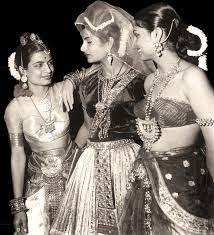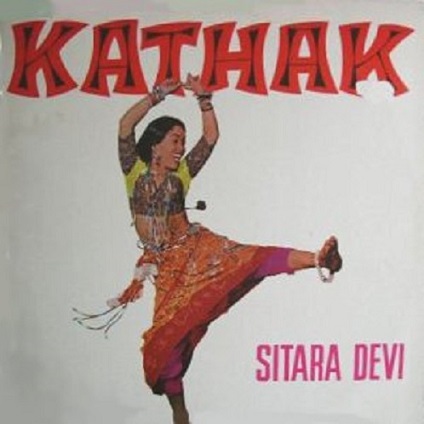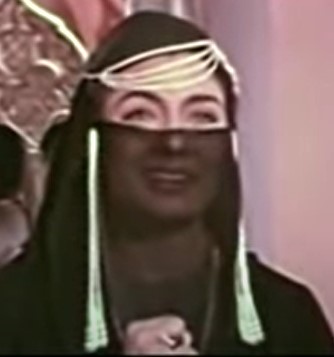I finally watched Basant (1942) all the way through last week (after watching songs and snippets for the past couple of years), and I enjoyed it. I thought of doing a regular film write-up, but I haven’t been in the mood to go into the details and plot descriptions that a real, full write-up might require. Suffice to say, it was a charming and uplifting film. It did not seem like the most original film ever made, but as I’ve said about some other films from the 1940s that I saw after watching so many from the ’50s and beyond, if I found some of the film to be cliched, I appreciated the fact that at least the cliches were a bit newer in this movie than in most. (And by the way, I noticed a strong similarity in plot between Basant and the Golden Age film Kathputli (1957).) Basant also has truly delightful music, composed by Anil Biswas and his brother-in-law Pannalal Ghosh, with much of it sung by Anil’s sister (and Pannalal’s wife), Parul Ghosh. (Some of these films were quite the family affair, especially in the music department.) And it has an all-around great cast. It is always a pleasure to watch an acting performance by Ulhas, even when he plays a real jerk (as he did both here and in Lal Haveli (1944)). Also apart from the three Mumtazes (whom I will get to in a minute), it was a pleasure, finally, to see a substantial film role played by Pramila, the Vintage-era Jewish beauty queen. She did quite well playing the role of jealous villainess, and she also did some nice dancing. But within this cast, I still think I had the greatest fun watching the three Mumtazes.
Since I already mentioned Pramila, let’s start the main part of this post with the dance that she did with Mumtaz Ali. Until a short while ago, I could not even find film scenes of Mumtaz Ali in his heyday, but, thankfully, I have not had that problem during the last couple of years. He was very charming back in the early 1940s, and his two dances in this film are very nice in addition to being historically significant. And, as I was saying, Pramila is very good here, too.
The second time Mumtaz Ali dances, it is with another Mumtaz, Mumtaz Shanti. I have seen some people complain that they are not crazy about Mumtaz Shanti or her acting style, but I have to strongly disagree. I loved her performance in Kismet (which was made one year later), and I love her here, too. She is very sweet in both films, and she seems to be well suited for the role of the good heroine. She is also quite cute. She is definitely one of my favorite actresses from films of the ’40s.
Among the Mumtaz Shanti songs in this film, my favorite is “Mere Chhote Se Man Mein…” Part of the reason for this might be that I had been listening to the song for years before I ever saw it in Basant. A few years ago, I downloaded a number of MP3s of songs sung by Parul Ghosh, and this happened to be the one that I picked to listen to most often. The tune is very catchy, and that might be why it is featured in the film three times. But the best time it is featured is when Parul Ghosh sings it for Mumtaz Shanti. (By the way, the clip below seems to have a different title from the other two versions, coming more from the second phrase in the song. I don’t know if that listing difference exists in any other copies of the film, but it is definitely the same song.)
I am almost equally fond of another song in the film, “Tumko Mubarak Ho,” which we get to hear twice. Mumtaz Shanti is quite wonderful performing this one. She is the perfect actress to perform a song of poor people telling off the rich, explaining why the poor are more virtuous than the rich. (And that is a type of song that is also close to my heart.) Just look at Mumtaz’s expressions! She is adorable.
The next time we see this song performed in the film, it is sung – both on screen and off – by this strange-looking, chubby child. This is the third Mumtaz in the film, Baby Mumtaz. Some years later, she would become Madhubala, the great beauty queen. Who would ever have thought…?
And at the end of the film, Baby Mumtaz also gives a song-and-dance performance of “Mere Chote Se Man Mein” with her filmi parents, Mumtaz Shanti and Ulhas, looking on. This final performance in Basant gives us the best reason to value this movie for its historical significance alone.
Unfortunately, the sound in the copy of the film that I am linking to is not always very good, but in other ways this copy is exceptional. One reason, of course, is that it was put up on YouTube by that most frequent source of film clips for this blog, Tom Daniel, so the visual quality of this film and its songs is better than in any other copies that were posted. Another reason is that it was custom-subtitled in English by Reeba (aka in comments as Pacifist). She apparently did a fine job, because I very much enjoyed some of the dialogue and, especially, the lyrics (which were written by P.L. Santoshi). Since my own Hindi skills are still quite rudimentary (and slipping at this point), there is no way I could have come close to understanding and enjoying this movie as much without these subtitles. And unless, say, Shemaroo Vintage distributed a new copy in the U.S., it might be the only English-subtitled copy of the film available. So, especially if you, too, are Hindi-challenged, I highly recommend looking at this version of Basant.




… and yet another film to watch! Just when I thought I was beginning to get somewhere with the list. :-) Reading Balraj Sahni’s autobiography had already made me bookmark several of his early films on Youtube (including Dharti ke Laal), and there are a bunch of other early Dev Anand films I’d bookmarked when I was doing research for an article I had to write about him. And now this, which I’d see just for Mumtaz Ali and little Madhubala (yes, I’m not one of the Mumtaz Shanti fans, though it’s not as if I outright hate her).
Thanks for the review, Richard.
You’re welcome, Madhu.
By the way, that Dev Anand article looks interesting. I am curious about which of his early films are on your list. (I’ve seen Shair and most of Jeet, from ’49, and I feel as though I saw Ham Ek Hain because I’ve seen all the songs and have read a lot about it. :) )
Of course, I need to see Dharti Ke Lal sometime, too.
But, for me, the quest also always involves trying to find a copy with subtitles. (Maybe that will change some day…)
Anyway, I hope you do get to Basant sometime soon. It’s pretty light and easy to get through. There is a slightly annoying part that, as I said, is just like a part of Kathputli (it’s the husband-becomes-a-big-asshole part), but most of it really is fun and enjoyable.
The Dev Anand article was for an anthology on winners of the Dadasaheb Phalke Award, Richard – a book published by the Publications Division, of the Government of India. I believe the only place it’s going to be available is at the ongoing book fair. Sadly, I had strict instructions to limit the article to 3,000 words – and it had to be biographical. So I chose to do a blend of biography and analysis of what comprised Dev Anand’s onscreen persona. I didn’t have much scope to dwell on his early films.
I do hope someone subs Dharti ke Lal. More than that (since I’ve seen it, can vouch for it, and think you’ll like it), Neecha Nagar. Excellent film.
Hi Richard! You have a wonderful blog enticing enough to spend hours here. Thank you for your efforts. Is the photo on top of this page that of Madhubala (Baby Mumtaz) in the movie Basant? I used it on a Facebook group as such. Please enlighten.
Hello, Victor. Thank you for the very nice words. I am certainly glad that you find this blog so interesting!
I am not sure if you are referring to the picture at the very top of the blog… That is what WordPress calls the “image header,” and it appears on all pages. It is Kumkum in Kohinoor (in the famous song).
You can see Madhubala/Baby Mumtaz in the last two videos of the post.
I hope that didn’t cause any confusion!
BTW, I am curious re. which Facebook group you are referring to. Some people have added me to a couple that I almost never look at (unfortunately), unless I catch some of the posts in my news feed. There is only so much time! But there are others that I see a little more often (though I probably haven’t seen any this week, because I’ve been away from my computer and offline a lot).
I am really glad I discovered your writings and the supporting material. They are very interesting, well researched, and well put – a rather rare combination. I was referring to the cherubic face on the right of the title “The Three Mumtazes in Basant (1942).” I thought of it as belonging to Madhubala, but sharp eyed members of the group are insistent it instead belongs to Usha Kiran and I’m feeling the weight of their combined opinion! Could you please favor me with a quick Yes or No? That will enable me to declare a confirmation or a correction of my solitary stance.
Our FB group is Madhubala specific (https://www.facebook.com/groups/madhubala/), an eye-cooler and a heart-warmer for her admirers. Please do visit and join to enhance it with your vast knowledge.
And thanks for your reply.
Thank you again, Victor!
But the sharp-eyed members of your group are right. That is Usha Kiran in the film Madhosh (1951).
Thank you Richard! That settles the matter in Usha Kiran’s favor. I look forward to seeing you at our FB Group for Madhubala.
Great movie and review Richard. Thanks so much – it’s a real pleasure to tap into your vast knowledge and love for these gems!
Aditya, you are welcome, and thank you so much for the compliments!
My pleasure Richard. If it would be possible for you to list all the movies that you have reviewed that would be a real treasure!
Aditya, sorry I took more than a dozen days to answer your last comment. :) But, frankly, I am not much up for listing all the movies that I have “reviewed.” There are a couple of reasons:
1. Listing all the movies mentioned here involves a lot of time and energy that I would rather spend doing other things.
2. I am not sure when I can claim that I “reviewed” a movie. I don’t always do straight write-ups with plot synopsis, comments about the actors and characters, etc. A few of my blogging friends have done such a thing more consistently, and they deserve credit for that. Sometimes I like to look at films in a few different ways: Say, like just going over the songs or the dances. Or, maybe, talking about a film specifically in terms of the way that it deals with a certain theme or subject or strictly in terms of its social relevance. (For instance, I did all of that in relation to the first Hindi film that I totally fell for since I started this blog, Shree 420. I did it in a few posts. But I never wrote a proper review of that movie.) I’ve also written posts that were just comparisons of two different movies. So, anyway, what’s a “review” and what isn’t?
If you want to know whether and how I mentioned a certain movie, I encourage you to use the search engine! (I made sure that was in a good place on the blog, very visible. Some blogs out there make it a little more difficult to figure out how to search for something, but I wanted that to be easy here.)
Thanks Richard.. Will try the search button.
Hi Richard! Last week, I had to write a review of Bandar for the news-website I work for and serendipitously, I stumbled upon your beautiful blog! I don’t know how to put in words, but your writing is charming. I regularly spend hours and hours on your blog reading about these forgotten films. Loved this write-up too.
And talking about Basant, I may disagree. I thought Pramila as Meena Devi overshadowed everybody on screen. She infused insecure Meena with so much humour and sarcasm. So for me, this movie is brilliance of Pramila!
Anup, thank you very much for those nice words. I am truly delighted to see that you find my writing charming, and the fact that you spend hours and hours reading about these films on my blog makes me feel a little less crazy for spending hours and hours writing about them! :)
It is interesting to read about your “disagreement” with my write-up here, but it is certainly not that big of a disagreement, because, as I said, I thought Pramila was very good, too. I certainly understand your perspective on this!